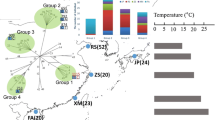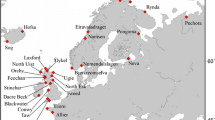Abstract
The role of natural selection in maintaining inherited variation in morphological characters is indisputable. In contrast, genetic variation in allozyme loci is mostly assumed neutral or under weak selection, although enzyme functions are critical to central metabolic processes. A locus coding for aspartate aminotransferase (AAT) is polymorphic with two alleles in the rocky shore gastropod Littorina saxatilis. One allele (Aat 120) is most frequent (0.8–0.9) in upper shore subpopulations, while the other (Aat 100) dominates (0.7–0.8) lower shore subpopulations only meters below. Earlier studies show this variation to be maintained by divergent selection, but the mechanism is unknown. We measured enzyme activities in AAT extracts from individuals of known Aat genotype in populations from two islands and at three different temperatures. In all treatments lower shore homozygotes (Aat 100/100) had higher enzyme activity than upper shore homozygotes (Aat 120/120), with heterozygotes having intermediate levels of activity. AAT has a central role in anaerobic energy production in marine mollusks during low-tide periods of emergence, and it might appear surprising that upper shore snails, which are most likely to be emerged, have lower enzyme activity. However, upper shore snails are forced to survive long periods of desiccation, and a low metabolic rate will help to conserve limited resources of energy and nutrients and reduce accumulation of waste products.



Similar content being viewed by others
References
Armbruster GFJ (2001) Selection and habitat-specific allozyme variation in the self fertilizing land snail Cochlicopa lubrica (O.F. Müller). J Nat Hist 35:185–199
Bergmeyer HU (ed) (1983) Enzymes 1: oxidoreductases, transferases. Methods of enzymatic analysis, vol III. Verlag Chemie, Weinheim, pp 416–444
Boulding EG, Holst M, Pilon V (1999) Changes in selection on gastropod shell size and thickness with wave-exposure on northeastern Pacific shores. J Exp Mar Biol Ecol 232:217–239
Bullock TH (1955) Compensation for temperature in the metabolism and activity of poikilotherms. Biol Rev Camb Philos Soc 30:311–342
Cornish-Bowden A (1976) Principles of enzyme kinetics. Butterworth, London
Day TH, Hillier PC, Clarke B (1974) Properties of genetically polymorphic isozymes of alcohol dehydrogenase in Drosophila melanogaster. Biochem Genet 11:141–153
de Zwaan A (1991) Molluscs. In: Bryant C (ed) Metazoan life without oxygen. Chapman and Hall, London, pp 186–217
Eanes WF (1987) Allozymes and fitness: evolution of a problem. Trends Ecol Evol 2:44–48
Eanes WF (1999) Analysis of selection on enzyme polymorphisms. Annu Rev Ecol Syst 30:301–326
Endler JA (1986) Natural selection in the wild. Princeton University Press, Princeton, N.J., USA
Erlandsson J, Rolán-Alvarez E, Johannesson K (1998) Migratory differences between ecotypes of the snail Littorina saxatilis on Galician rocky shores. Evol Ecol 12:913–924
Gardner JPA, Palmer NL (1998) Size-dependent, spatial and temporal genetic variation at a leucine aminopeptidase (LAP) locus among blue mussel (Mytilus galloprovincialis) populations along a salinity gradient. Mar Biol 132:275–281
Garthwaite RL (1989) Leucine aminopeptidase variation and fitness parameters in the estuarine bivalve Geukenzia demissa. Mar Biol 103:183–192
Hawkins AJS (1995) Effects of temperature change on ectotherm metabolism and evolution: metabolic and physiological interpretations underlying the superiority of multi-locus heterozygotes in heterogeneous environments. J Therm Biol 20:23–33
Hedrick PW, Ginevan ME, Ewing EP (1976) Genetic polymorphism in heterogeneous environments. Annu Rev Ecol Syst 7:1–32
Hochachka PW (1980) Living without oxygen: closed and open systems in hypoxia tolerance. Harward University Press, Cambridge, Mass., USA, pp 27–41
Hochachka PW, Somero GN (1984) Biochemical adaptation. Princeton University Press, Princeton, N.J., USA
Hull SL, Grahame J, Mill PJ (1999) Heat stability and activity levels of aspartate aminotransferase and alanine aminotransferase in British Littorinidae. J Exp Mar Biol Ecol 237:255–270
Hummel H, Sommer A, Bogaards RH, Pörtner HO (1997) Variation in genetic traits of the lugworm Arenicola marina: temperature related expression of mitochondrial allozymes? Mar Ecol Prog Ser 159:189–195
Janson K (1983) Selection and migration in two distinct phenotypes of Littorina saxatilis in Sweden. Oecologia 59:58–61
Johannesson B, Johannesson K (1996) Population differences in behaviour and morphology in snail Littorina saxatilis: phenotypic plasticity or genetic differentiation? J Zool (Lond) 240:475–493
Johannesson K, Johannesson B (1989) Differences in allele frequencies of Aat between high- and mid-rocky shore populations of Littorina saxatilis (Olivi) suggest natural selection in this enzyme locus. Genet Res 54:7–11
Johannesson K, Tatarenkov A (1997) Allozyme variation in a snail (Littorina saxatilis)—deconfounding the effects of microhabitat and gene flow. Evolution 51:402–409
Johannesson K, Johannesson B, Rolán-Alvarez E (1993) Morphological differentiation and genetic cohesiveness over a microenvironmental gradient in the marine snail Littorina saxatilis. Evolution 47:1770–1787
Johannesson K, Johannesson B, Lundgren U (1995) Strong natural selection causes microscale allozyme variation in a marine snail. Proc Natl Acad Sci USA 92:2602–2606
Johannesson K, Rolán-Alvarez E, Erlandsson J (1997) Growth rate differences between upper and lower shore ecotypes of the marine snail Littorina saxatilis (Olivi)(Gastropoda). Biol J Linn Soc 61:267–279
Kimura M (1991) Recent development of the neutral theory viewed from the Wrightian tradition of theoretical population genetics. Proc Natl Acad Sci USA 88:5969–5973
Kinne O (1962) Irreversible nongenetic adaptation. Comp Biochem Physiol 5:265–282
Kinne O (ed) (1975) Marine ecology: a comprehensive, integrated treatise on life in oceans and coastal waters, vol 2. Physiological mechanisms, part 1. Wiley, London
Koehn RK, Zera AJ, Hall JG (1983) Enzyme polymorphism and natural selection. In: Nei M, Koehn RK (eds) Evolution of genes and proteins. Sinauer, Sunderland, Mass., USA, pp 115–136
Kreitman M, Akashi H (1995) Molecular evidence for natural selection. Annu Rev Ecol Syst 26:403–422
Malpica JM, Vassallo JM (1980) A test for the selective origin environmentally correlated allozyme patterns. Nature 286:407–408
McDonald JF, Anderson SM, Santos M (1980) Biochemical differences between products of the Adh locus in Drosophila. Genetics 95:1013–1022
McMahon RF (1990) Thermal tolerance, evaporative water loss, air–water oxygen consumption and zonation of intertidal prosobranchs: a new synthesis. Hydrobiologia 193:241–260
McMahon RF, Russell-Hunter WD, Aldridge DW (1995) Lack of temperature compensation in the intertidal gastropods, Littorina saxatilis (Olivi) and L. obtusata (L.). Hydrobiologia 309:89–100
Merilä J, Crnokrak P (2001) Comparison of genetic differentiation at marker loci and quantitative traits. J Evol Biol 14:892–903
Mill PJ, Grahame J (1995) Shape variation in the rough periwinkle Littorina saxatilis on the west and south coasts of Britain. Hydrobiologia 309:61–71
Newell RC (1976) Adaptation to environment: essays on the physiology of marine animals. Butterworth, London
Newell RC (1979) Biology of intertidal animals. Marine ecological surveys, Faversham, Kent
Oakeshott JG, Gibson JB, Anderson PR, Knibb WR, Anderson DG, Chambers GK (1982) Alcohol dehydrogenase and glycerol-3-phosphate dehydrogenase clines in Drosophila melanogaster on different continents. Evolution 36:86–96
Pierce VA, Crawford DL (1997) Phylogenetic analysis of thermal acclimation of the glycolytic enzymes in the genus Fundulus. Physiol Zool 70:597–609
Place AR, Powers DA (1979) Genetic variation and relative catalytic efficiencies: lactate dehydrogenase-B allozymes of Fundulus heteroclitus. Proc Natl Acad Sci USA 76:2354–2358
Powers DA, Schulte PM (1998) Evolutionary adaptations of gene structure and expression in natural populations in relation to a changing environment: a multidisciplinary approach to address the million-year saga of a small fish. J Exp Zool 282:71–94
Powers DA, Lauerman T, Crawford D, DiMichele L (1991) Genetic mechanisms for adapting to a changing environment. Annu Rev Genet 25:629–659
Read KRH (1963) Thermal inactivation of preparations of aspartic/glutamic transaminase from species of bivalved molluscs from the sublittoral and intertidal zones. Comp Biochem Physiol 9:161–180
Reid DG (1996) Systematics and evolution of Littorina. Ray Society, London
Rolán-Alvarez E, Johannesson K, Erlandsson J (1997) The maintenance of a cline in the marine snail Littorina saxatilis: the role of home site advantage and hybrid fitness. Evolution 51:1838–1847
Skibinski DOF, Woodwark M, Ward RD (1993) A quantitative test of the neutral theory using pooled allozyme data. Genetics 135:233–248
Sokolova IM, Berger VJa (2000) Physiological variation related to shell colour polymorphism in White Sea Littorina saxatilis. J Exp Mar Biol Ecol 245:1–23
Sokolova IM, Pörtner HO (2001a) Temperature effects on key metabolic enzymes in Littorina saxatilis and L. obtusata from different latitudes and shore levels. Mar Biol 139:113–126
Sokolova IM, Pörtner HO (2001b) Physiological adaptations to high intertidal life involve improved water conservation abilities and metabolic rate depression in Littorina saxatilis. Mar Ecol Prog Ser 224:171–186
Sokolova IM, Granovitch AI, Berger VJa, Johannesson K (2000) Intraspecific physiological variability of the gastropod Littorina saxatilis related to the vertical shore gradient in the White and North Seas. Mar Biol 137:297–308
Sommer AM, Pörtner HO (2002) Metabolic cold adaptation in the lugworm Arenicola marina: comparison of a North Sea and a White Sea population. Mar Ecol Prog Ser 240:171–182
Tatarenkov AN, Johannesson K (1994) Habitat related allozyme variation on a microgeographic scale in the marine snail Littorina mariae (Prosobranchia, Littorinacea). Biol J Linn Soc 53:105–125
Thorpe JP, Solecava AM (1994) The use of allozyme electrophoresis in invertebrate systematics. Zool Scr 23:3–18
Underwood AJ (1997) Experiments in ecology. Their logical design and interpretation using analysis of variance. Cambridge University Press, Cambridge
Watt WB, Dean AM (2000) Molecular-functional studies of adaptive genetic variation in prokaryotes and eukaryotes. Annu Rev Genet 34:593–622
Watt WB, Donohue K, Carter PA (1996) Adaptation at specific loci. VI. Divergence vs. parallelism of polymorphic allozymes in molecular function and fitness-component effects among Colias species (Lepidoptera, Pieridae). Mol Biol Evol 13:699–709
Author information
Authors and Affiliations
Corresponding author
Additional information
Communicated by L. Hagerman, Helsingør
Rights and permissions
About this article
Cite this article
Panova, M., Johannesson, K. Microscale variation in Aat (aspartate aminotransferase) is supported by activity differences between upper and lower shore allozymes of Littorina saxatilis . Marine Biology 144, 1157–1164 (2004). https://doi.org/10.1007/s00227-003-1274-6
Received:
Accepted:
Published:
Issue Date:
DOI: https://doi.org/10.1007/s00227-003-1274-6




